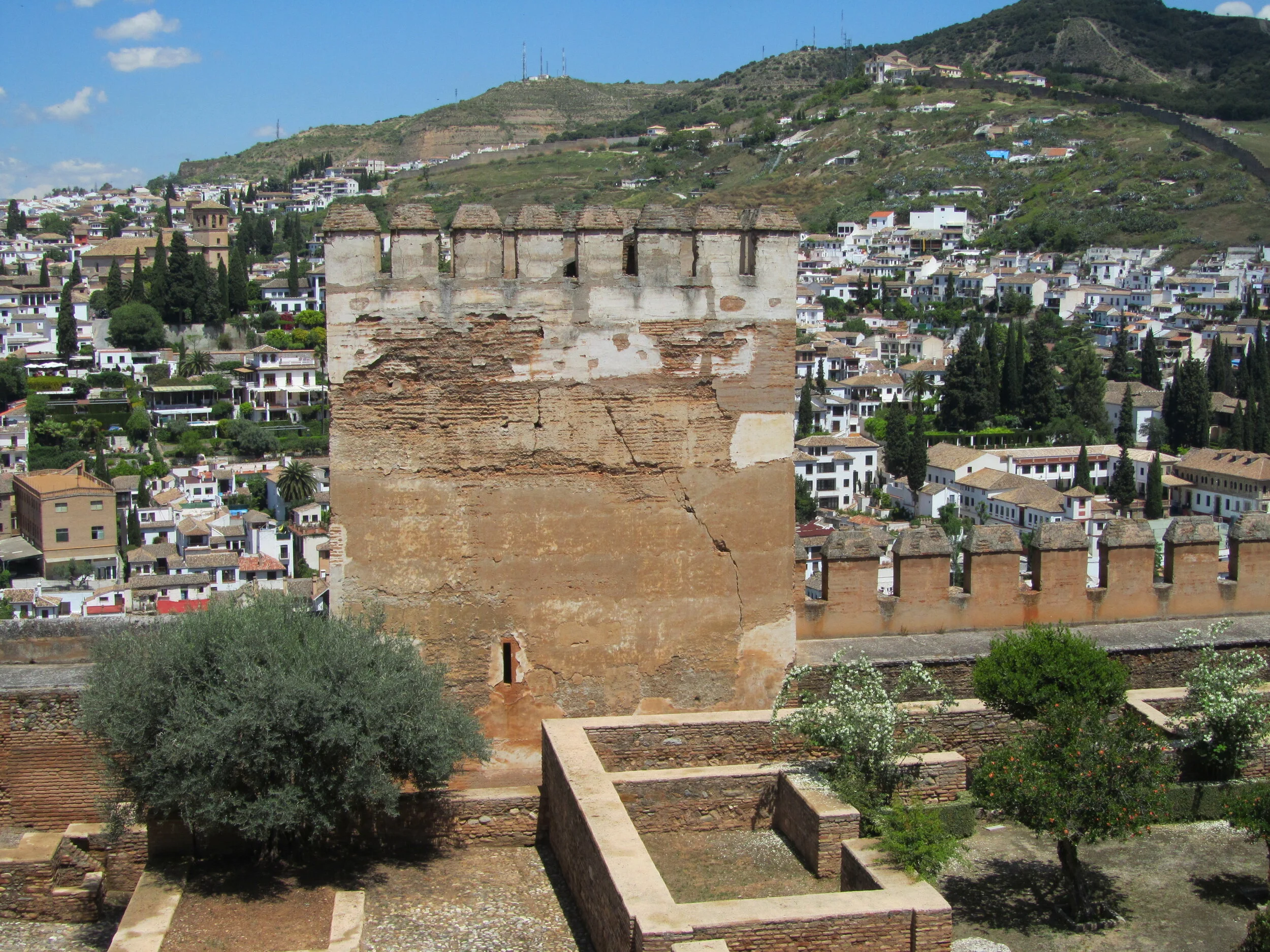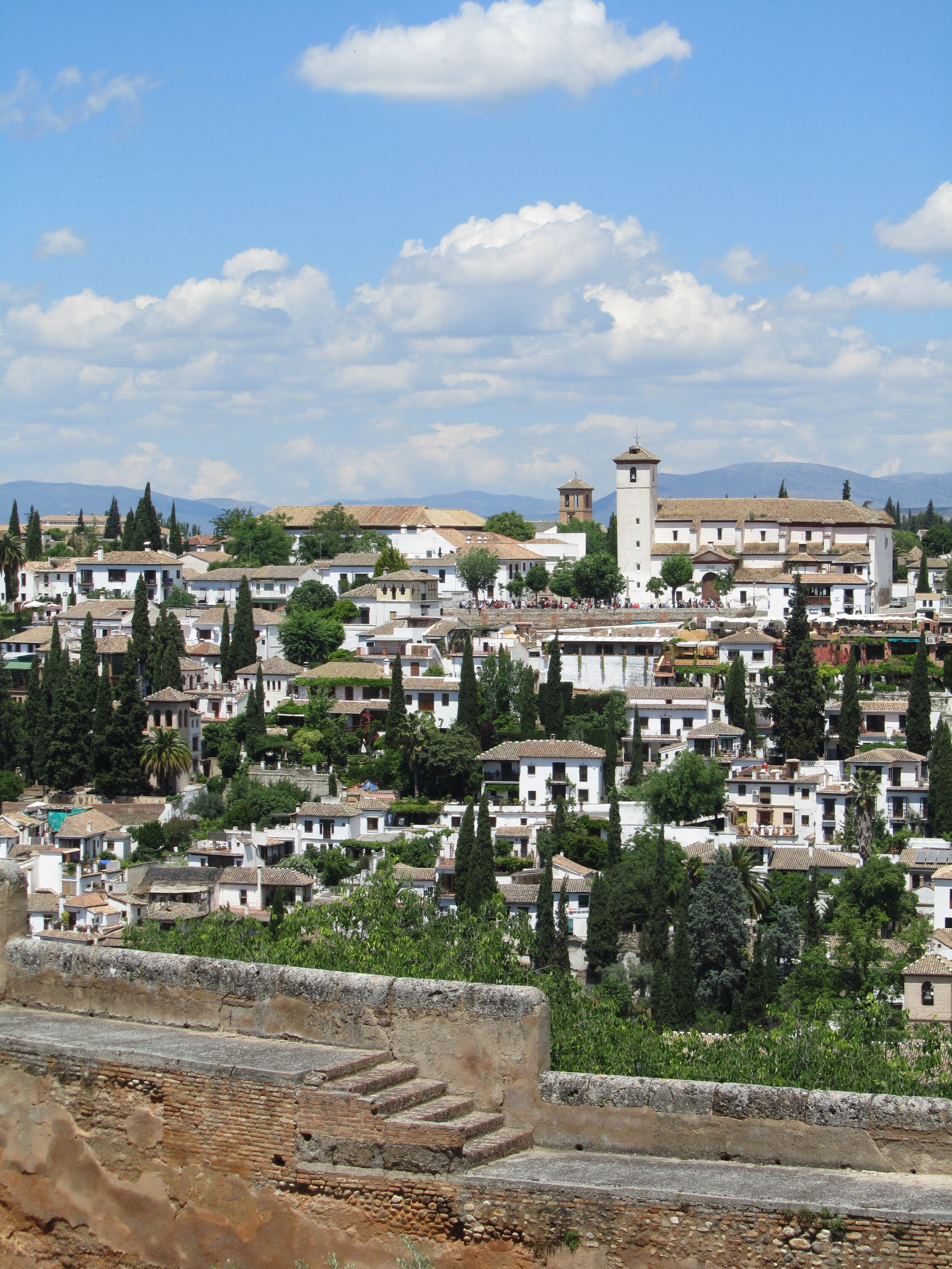Tour the towers of the defensive outpost perched above the charming city of Granada in the South of Spain.
Start your tour of the Alhambra with the Generalife gardens and the Alcazaba fortress.
With the snow-capped peaks of the Sierra Nevada as a backdrop, it’s easy to see why the monumental fortress palace of the Alhambra is one of the most visited monuments in Spain, second only to the Sagrada Família in Barcelona.
The complex of buildings was fittingly recognized as a UNESCO World Heritage Site in 1984, and served as residence to the Islamic sultanates of the Iberian Peninsula. Muslims ruled the region from the 11th to 15th century, until conquered by the Catholic monarchy in 1492. The Alhambra’s name comes from the Arabic al-Qal’at al-Hamra, or Red Fortress, owing to the reddish color of the clay-rich soil of the al-Sabika Hill ridge, where it rises from the terrain. That same ochre soil was used in the rammed, or compressed, earth brick walls of this impressive complex.
“ A fortress doesn’t do any good if you simply open its doors to invaders.
But that’s exactly what King Boabdil did, after his fellow Muslims had ruled the region for nearly 700 years. ”
Touring the Alcazaba and the rest of the Alhambra made for a birthday Wally will never forget!
After literally taking time to stop and smell the roses in the gardens of the Generalife, we made our way to the Alcazaba, the fortress that once guarded the palace. We had booked our tickets for a guided tour (about 46€) months before, and a small group of ill-mannered and boisterous British tourists were part of our entourage. One of them was a doddering old man named Leslie, who frequently strayed from the group, and whose companions could be heard incessantly shouting, “Leslie! Leslie, come here!” to reel him back in.
This is Leslie, wandering off again. “Leslie! Get back here!”
Plaza de los Aljibes, the Square of the Cisterns
Our group arrived at the Plaza de los Aljibes, the Square of the Cisterns, built after the Christian victory. The broad open space got its name from the underground cisterns built to collect rainwater below the square because the new occupants didn’t understand the complexities of the water channels the Arab engineers had created, leaving the aqueducts to fall into disrepair. Off to one side of the square lie the Nasrid Palaces, to the other, the Alcazaba.
The entrance to the Alcazaba, built by Muhammad I, the first sultan of the Nasrid dynasty
The Alcazaba Fortress
The austere military enclosure of the Alcazaba fortress is strategically positioned at the summit of the westernmost end of the monumental site, overlooking the city of Granada. Its construction is attributed to Muhammad I (who reigned from 1238-1273), the founder of the Nasrid dynasty. A stark contrast to the opulent and residential Nasrid Palaces, its primary function was to shield its inhabitants from external attacks.
The separations in the defensive wall allowed archers to fire at invaders.
Of the whole set of structures within the Alhambra, the Alcazaba is the oldest. The north-facing walls were built atop the remains of a 9th century castle constructed for the Zirid dynasty, who were Berbers from Algeria, and incorporated into the foundation walls. Here, Muhammad I strengthened the enclosure walls and constructed three of its 30 imposing towers. Our group entered the fortress from the plaza through a doorway cut into the high east-facing wall.
Torre del Homenaje, the Tribute Tower
Located at the northeast corner of the perimeter wall is the keep, known as the Torre del Homenaje, which could be translated as the Tribute Tower or the Tower of Homage. It’s one of the highest of the Alhambra and was strategically the most important, as it served both defensive and offensive purposes. The upright crenellated “teeth,” aka the battlements along the top of the tower, protected sentries from attacks and allowed them to fire arrows at intruders. Throughout its history, the tower served many functions, including as royal residence to Muhammad I and as a prison during the Christian occupation.
The towers of the Alcazaba, the Torre de la Vela in particular, provide great views of the white city of Granada below.
Torre de la Vela, the Watchtower
The Torre de la Vela, the Watchtower, defiantly perches on the far west end of the hill, where the previously mentioned modest Zirid castle once stood. It served as a watchtower, and the interior consists of four floors plus the terrace and a subterranean dungeon—a kind of command center in the middle of the fortress.
Wally and I climbed the narrow staircase to the top to take in the panoramic bird’s-eye view of the rolling Andalusian hills and Albaicín, Granada’s Moorish neighborhood. The terrace is crowned by a bell tower, added by the Christian kings in the 18th century, which was used to signal significant news to the general populace.
There are many thoughts on the origin of its name. The literal translation of the word vela is “candle,” but one theory posits that the bell was brought from Castil de Vela, a municipality located in the province of Palencia. Then again, it could be connected to the verb desvelar, which means to keep awake, possibly referring to the sounding bell and its ability to awaken anyone below from slumber. In any event, the bell is rung every January 2 to celebrate the taking of Granada from the Muslim sultans.
The Alcazaba at the Alhambra is cool to tour — but just wait till you see the ornate Nasrid Palaces!
Torre Quebrada, the Broken Tower
This imposing monolithic tower stands within the shadow of the Torre de la Vela. I couldn’t find any specifics as to how it acquired its name, but one could presume that it suffered from seismic activity, or Napoleon's army, which decided to inflict damage by blowing up a few of the towers when they withdrew from the palace, petty and bitter at having lost the Peninsular War, which took place from 1808-1814.
Visitors had to leave their weapons at the Puerta de las Armas.
Puerta de las Armas, the Gate of Arms
Originally, the Bab al-Silas, or Puerta de las Armas, the Gate of Arms, functioned as the populace’s primary entrance. The doorway probably got its name from its associated use: Visitors were stopped and required to leave their weapons behind before gaining access.
Part of the Plaza de las Armas contains the ruins of the Barrio Castrense, the foundations of the residential dwellings for the royal guard and soldiers needed for the defense of the sultan.
The foundations of the military quarters can still be seen in the Plaza de la Armas.
The Surrender of Granada by Francisco Pradilla y Ortiz, 1882, shows poor Baobdil turning over the keys to Granada to Ferdinand and Isabella.
Letting the Catholics In
A fortress doesn’t do you any good if you simply open its doors to invaders. But that’s exactly what King Boabdil did, after his fellow Muslims had ruled the region for nearly 700 years.
On January 2, 1492, Ferdinand II of Aragon and Isabella of Castile ceremoniously entered Granada, curiously in Muslim dress. They set up court in the Alhambra declaring it a Casa Real, or royal residence. One of their first orders of business? Declaring that all Jews and Muslims had to convert to Catholicism or leave the country. –Duke






























